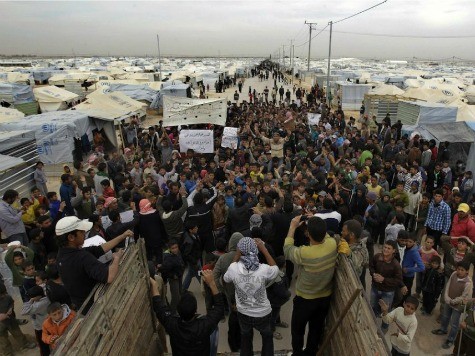
Middle Eastern and North African refugees are streaming into European Union countries fleeing widespread unrest, and many may soon try to come to America.
When the Office of the United Nations High Commissioner for Refugees (UNHCR) was established in 1951, there were approximately 1.5 million refugees internationally. But last year the refugee population grew by 22% to 11.3 million. This rising tide is on track to swell to 14 million this year. Many of these people have been fighting for and against the United States and its European allies in Iraq, Afghanistan, Libya, Syria, and now Egypt. They know about America’s policy of open borders, and millions will likely flood into America.
On June 20th, António Guterres, UN High Commissioner for Refugees, said the number of Syrian refugees had grown by another million in the first six months of 2013 and now stands at 1.6 million people. He stated the entire nation of 22.5 million “is being left to self-destruct as it empties itself of its people.” He added: “With no clear political resolution in sight, this civil war is in real danger of sliding into a regional conflict.”
The European Union (EU) is already being inundated with asylum seekers and illegal immigrants from the Middle East, North Africa and the Caucasus. Under the Schengen Agreement, 26 EU countries agreed to eliminate their national border controls and stipulate that the country where refugees first arrive must also take care of them. The willingness of the immigrants to work for cash has magnified European unemployment rates and is heavily straining social welfare systems.
In the economically unstable countries of Greece, Spain, Italy, and Malta along the EU southern border, this has created an especially huge economic burden. The prevalence of anti-immigrant sentiment has undermined efforts to limit migration of refugees transiting onward to Western Europe. It is difficult to measure how many refugees have recently streamed into the EU. But data released Aug. 2 by Eurostat demonstrates the fraction of refugees that apply for asylum in the EU rose to 85,000 during the first quarter of 2013–an increase of roughly 15,000 over the same period a year earlier.
The increase in those seeking legal asylum has coincided with the onset of the European economic crisis. EU refugee applications rose steadily from 226,000 in 2008 to more than 335,000 by the end of 2012. Economically healthy Germany had the highest number of outstanding applications, followed by Greece, Belgium, France, and Sweden. Germany became the prime destination for asylum seekers after the German Constitutional Court ruled last year refugees are entitled to social benefits comparable to those of the German population and deeming any lower levels of aid to be inhumane.
During the first half of 2013, nearly 10,000 Russians applied for asylum in Germany versus 3,200 applications during the same period in 2012. Frankfurt’s Allgemeine newspaper, citing German intelligence services, claims 90% of applicants are Russians citizens from Chechnya. With the heavy crackdown on Muslim extremists in the Caucasus, Russian nationals are now second, behind Afghans, as the highest number of asylum seekers over the last four years.
The rise of the far-right Golden Dawn Party in Greece and other similar parties in other EU countries is linked to the surge in immigration. Greece’s geography makes the country an ideal destination for Middle East asylum seekers looking to travel deeper into the EU to gain access to economic stability, strong social benefits, favorable immigration policies, and existing large immigrant communities. Since 2008, the Greek economy has shrunk by 24%, business bankruptcies have skyrocketed, unemployment is at a record 27.6%, and unemployment is 64.9% for people under 25. Most refugees arriving in Greece lack the funds to travel deeper into Europe and have become unemployed squatters. Greeks blame the EU treaty for giving refugees many of the social services that benefits are being taken away from Greek citizens.
The U.S. refugee policy is controlled by the United States Refugee Admissions Program (USRAP) that sets the priority for entrance into the U.S. as 1) Cases referred to the program by UNHCR; 2) Groups with special humanitarian concerns; and 3) Family reunification cases. Last year the United States legally admitted 56,424 refugees and has set a ceiling at 70,000 refugees in 2013.
But this trickle could become a flood as America withdraws from its involvement in civil wars such as in Syria. When America withdrew from South Vietnam in 1974, the country had a population of 19.6 million people. Despite aggressive enforcement of immigration restrictions during that period, over 823,000 “boat people” eventually gained refugee status and resettled in the United States.
Today, America’s borders are effectively open due to the “dreamer policy” that allows anyone who says they are under the age of 31, entered the United States before age 16, and have continuously lived in the country for at least five years. Afghanistan, Iraq, Syria, Egypt and Libya have a combined population of about 180 million people. As America withdraws from the Middle East and North Africa, a huge number of the refugees from losing side of these civil wars could likely flood into America.

COMMENTS
Please let us know if you're having issues with commenting.